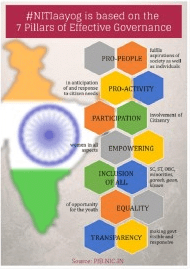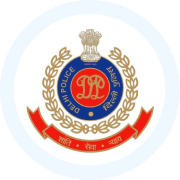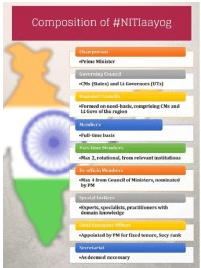Delhi Police Constable Exam > Delhi Police Constable Notes > NITI Aayog: A Critical Analysis
NITI Aayog: A Critical Analysis - Delhi Police Constable PDF Download

Introduction
- The Government had replaced Planning Commission with institution NITI Aayog (National Institution for Transforming India). The reason had mentioned that specific to the planning process, there is a need to separate as well as energize the distinct ‘process’ of governance from the ‘strategy’ of governance.
- An important evolutionary change from the past will be replacing a centre-to-state one-way flow of policy by a genuine and continuing partnership with the states.
- The institution must have the necessary resources, knowledge, skills and, ability to act with speed to provide the strategic policy vision for the government as well as deal with contingent issues.
Background
Objectives and Opportunities
NITI Aayog will aim to accomplish the following objectives and opportunities:
- An administration paradigm in which the Government is an “enabler” rather than a “provider of first and last resort.”
- Progress from “food security” to focus on a mix of agricultural production, as well as actual returns that farmers get from their produce.
- Ensure that India is an active player in the debates and deliberations on the global commons.
- Ensure that the economically vibrant middle-class remains engaged, and its potential is fully realized.
- Leverage India’s pool of entrepreneurial, scientific and intellectual human capital.
- Incorporate the significant geo-economic and geo-political strength of the Non-Resident Indian Community.
- Use urbanization as an opportunity to create a wholesome and secure habitat through the use of modern technology.
- Use technology to reduce opacity and potential for misadventures in governance.
Structure and Composition of NITI Aayog

Arguments that support NITI Aayog Relevance
- The NITI Aayog was formed to bring fresh ideas to the government. Its first mandate is to act as a think tank.
- It can be visualised as a funnel through which new and innovative ideas come from all possible sources — industry, academia, civil society or foreign specialists — and flow into the government system for implementation.
- Initiatives like Ayushmaan Bharat, our approach towards artificial intelligence and water conservation measures, and the draft bill to establish the National Medical Commission to replace the Medical Council of India have all been conceptualised in NITI Aayog, and are being taken forward by the respective Ministries.
- Acted as an Action Tank:
- NITI Aayog acted as an action tank rather than just a think tank. By collecting fresh ideas and sharing them with the Central and State governments, it pushes frontiers and ensures that there is no inertia, which is quite natural in any organisation or institution.
- NITI Aayog also works to cut across the silos within the government. For example, India still has the largest number of malnourished children in the world. NITI Aayog is best placed to achieve this convergence and push the agenda forward in the form of POSHAAN ABHIYAAN.
- NITI Aayog is also bringing about a greater level of accountability in the system.
- NITI Aayog has established a Development Monitoring and Evaluation Office which collects data on the performance of various Ministries on a real-time basis. The data are then used at the highest policymaking levels to establish accountability and improve performance.
- This performance- and outcome-based real-time monitoring and evaluation of government work can have a significant impact on improving the efficiency of governance.
- Using such data, it has also come up with performance-based rankings of States across various verticals to foster a spirit of competitive federalism.
- NITI Aayog plays an important role in being the States’ representative in Delhi, and facilitate direct interactions with the line ministries, which can address issues in a relatively shorter time.
Improving Innovation
- The Atal Innovation Mission, which is also established under NITI Aayog, has already done commendable work in improving the innovation ecosystem in India.
- It has established more than 1,500 Atal Tinkering Labs in schools across the country and this number is expected to go up to 5,000 by March 2019.
- It has also set up 20 Atal Incubation Centres for encouraging young innovators and start-ups.
Arguments Against for the NITI Aayog
- NITI Aayog cannot transform a deeply unequal society into a modern economy that ensures the welfare of all its citizens, irrespective of their social identity.
- It has no role in influencing public or private investment.
- It does not seem to have an influence in policymaking with long-term consequences. For instance, demonetisation and the Goods and Services Tax.
- If it is a think-tank, it has to maintain a respectable intellectual distance from the Govt. of the day.
- Instead, we see uncritical praise of the Govt-sponsored schemes/programmes.
- It is not able to answer specific questions like, why 90% are working in the unorganised sector? and more over as on date, more and more informalisation is taking place in the organised sector.
- Labour force participation rate of women is also declining, when neighbours like Bangladesh are registering an increase.
- NITI Aayog is supposed to be a think tank. This implies that while generating new ideas, it maintains a respectable intellectual distance from the government of the day.
Some of the Questions Need to be Answered
- How can a country like India transform itself with new ideas and strategies if it doesn’t have a paradigm of planning for development? How can it lift its poor?
- How can we ensure that every working member of the Indian population has a decent job with at least a minimum wage and social/employment security?
- Why doesn’t it occur to the political leadership to ask why more than 90% of those in the workforce slog in the unorganised sector in small farms and tiny non-farm establishments with two-thirds of the total being working poor?
- Why don’t they ask why more than half the workers in the organised sector end up as ‘insecure’ or ‘informal’ labour?
- Why is the labour force participation rate of women so low and declining when neighbours like Bangladesh have registered an increasing trend?
- Why do the Dalits and Adivasis continue to be at the bottom of the ladder in every conceivable social and economic indicator of well-being?
- Why do regional, gender and other inequalities based on social identity keep increasing?
Way Forward
- If NITI Aayog is to implement such a strategy within a planning framework in India, two major changes in governance structures are needed.
- First, planning will have to become more decentralised, but within a five-year plan framework.
- Second, the bureaucracy will need to change from generalist to specialist, and its accountability will have to be based on outcomes achieved, not inputs or funds spent.
- NITI Aayog should spell out how these reforms will be implemented.
- If it succeeds, NITI Aayog could emerge as an agent of change over time and contribute to the government’s agenda of improving governance and implementing innovative measures for better delivery of public services.
- With its unique and vibrant work culture, NITI Aayog remains an integral and relevant component of the government’s plans to put in place an efficient, transparent, innovative and accountable governance system in the country.
The document NITI Aayog: A Critical Analysis - Delhi Police Constable is a part of Delhi Police Constable category.
All you need of Delhi Police Constable at this link: Delhi Police Constable
FAQs on NITI Aayog: A Critical Analysis - Delhi Police Constable
| 1. What is NITI Aayog? |  |
Ans. NITI Aayog, or the National Institution for Transforming India, is a policy think tank of the Government of India. It was established in 2015 to replace the Planning Commission and focuses on providing strategic and technical advice to the central and state governments in order to achieve sustainable development goals.
| 2. What is the role of NITI Aayog in India's development? |  |
Ans. NITI Aayog plays a crucial role in India's development by formulating and implementing policies and programs that promote economic growth, social inclusion, and sustainable development. It acts as a catalyst for the cooperative federalism approach, facilitates collaboration between central and state governments, and provides a platform for policy dialogue and knowledge sharing.
| 3. How does NITI Aayog engage with different stakeholders? |  |
Ans. NITI Aayog engages with various stakeholders including central and state governments, industry bodies, civil society organizations, and academia. It conducts consultations, workshops, and seminars to gather inputs, feedback, and suggestions from these stakeholders. It also collaborates with international organizations and experts to exchange best practices and knowledge for effective policy formulation and implementation.
| 4. What are some key initiatives undertaken by NITI Aayog? |  |
Ans. NITI Aayog has undertaken several key initiatives to address various developmental challenges in India. Some of these include the Atal Innovation Mission to promote entrepreneurship and innovation, the Aspirational Districts Programme to drive socio-economic development in disadvantaged districts, the National Health Stack for comprehensive healthcare reforms, and the Sustainable Development Goals Index to monitor and track progress towards sustainable development goals.
| 5. What is the significance of NITI Aayog's three-year action agenda? |  |
Ans. NITI Aayog's three-year action agenda provides a roadmap and a strategic framework for achieving India's development objectives over a specific period. It outlines key policy priorities, sectoral strategies, and actionable recommendations for various sectors, including agriculture, education, healthcare, infrastructure, and governance. The three-year action agenda acts as a guiding document for policy formulation, implementation, and monitoring at both central and state levels.
Download as PDF

|
Explore Courses for Delhi Police Constable exam
|

|
Signup for Free!
Signup to see your scores go up within 7 days! Learn & Practice with 1000+ FREE Notes, Videos & Tests.
Related Searches


















